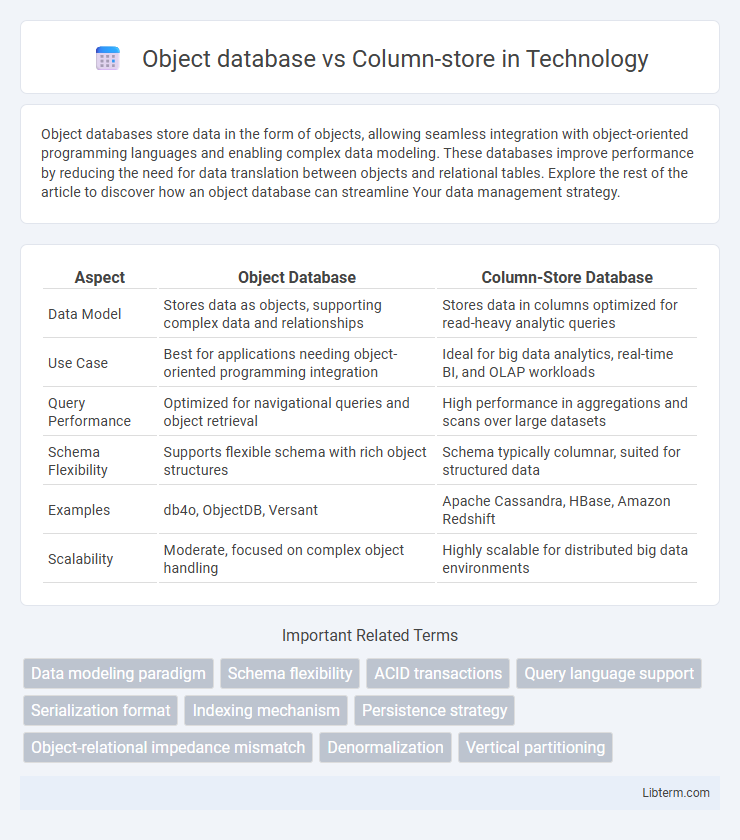Object databases store data in the form of objects, allowing seamless integration with object-oriented programming languages and enabling complex data modeling. These databases improve performance by reducing the need for data translation between objects and relational tables. Explore the rest of the article to discover how an object database can streamline Your data management strategy.
Table of Comparison
| Aspect | Object Database | Column-Store Database |
|---|---|---|
| Data Model | Stores data as objects, supporting complex data and relationships | Stores data in columns optimized for read-heavy analytic queries |
| Use Case | Best for applications needing object-oriented programming integration | Ideal for big data analytics, real-time BI, and OLAP workloads |
| Query Performance | Optimized for navigational queries and object retrieval | High performance in aggregations and scans over large datasets |
| Schema Flexibility | Supports flexible schema with rich object structures | Schema typically columnar, suited for structured data |
| Examples | db4o, ObjectDB, Versant | Apache Cassandra, HBase, Amazon Redshift |
| Scalability | Moderate, focused on complex object handling | Highly scalable for distributed big data environments |
Introduction to Object Databases and Column-Stores
Object databases store data as objects, aligning closely with object-oriented programming by encapsulating both state and behavior within the stored entities, which enhances complex data modeling and seamless application integration. Column-store databases organize data by columns instead of rows, optimizing read performance for analytical queries and enabling efficient compression and faster retrieval in big data environments. Comparing these, object databases excel in handling complex, interconnected data with rich semantics, while column-stores provide superior speed and efficiency for large-scale, read-intensive operations typical in data warehousing and business intelligence.
Core Architecture: Objects vs Columns
Object databases organize data as complex objects, closely aligning with object-oriented programming by encapsulating both state and behavior, enabling seamless data manipulation through objects and classes. Column-store databases, or columnar databases, structure data by columns rather than rows, optimizing for read-heavy analytical workloads by efficiently aggregating and compressing columnar data. The core architectural difference centers on data representation: object databases maintain data integrity with interconnected objects, while column-stores enhance query performance via column-wise storage and retrieval.
Data Modeling and Schema Flexibility
Object databases provide seamless data modeling by storing complex objects and their relationships directly, allowing for intuitive alignment with object-oriented programming paradigms and enabling schema flexibility through dynamic class definitions. Column-store databases optimize for analytical workloads by organizing data in columns, which supports sparse data, efficient aggregation, and flexible schema evolution via column addition or removal without major restructuring. Schema flexibility in object databases excels in handling nested and hierarchical data, while column-store systems prioritize adaptable schema for high-performance querying and large-scale data analytics.
Query Language and Access Patterns
Object databases use query languages like OQL (Object Query Language) tailored for navigating complex object relationships and accessing nested data structures efficiently. Column-store databases employ SQL with extensions for columnar operations, optimizing analytical queries that scan large datasets across specific columns. Object databases excel in applications requiring rich data models and hierarchical access, whereas column-stores thrive in read-heavy workloads with aggregations and sequential column access patterns.
Performance Considerations
Object databases offer efficient handling of complex data types and relationships, enabling faster retrieval of nested objects and reducing data transformation overhead. Column-store databases excel in read-heavy analytics workloads by optimizing disk I/O and CPU cache usage through columnar data compression and vectorized query execution. Performance depends on workload characteristics: object databases are superior for transactional applications requiring rich data models, while column-stores outperform in large-scale analytical queries with aggregations over massive datasets.
Scalability and Distributed Support
Object databases offer seamless scalability through native data modeling but often face challenges in distributed support due to complex object relationships. Column-store databases excel in distributed environments by allowing horizontal scaling and efficient partitioning across nodes, enabling rapid query performance over massive datasets. The inherent architecture of column-stores supports robust distributed transactions and replication, making them superior for large-scale, distributed analytics workloads.
Use Cases and Industry Applications
Object databases excel in applications requiring seamless integration of complex data types and real-world entities, making them ideal for computer-aided design (CAD), multimedia systems, and engineering simulations. Column-store databases optimize analytical query performance by efficiently handling large-scale, read-heavy workloads, commonly used in data warehousing, business intelligence, and real-time analytics across finance, retail, and healthcare industries. Enterprises choose object databases for deep object relationships and version control, while column-stores are favored for high-speed aggregation and trend analysis on massive datasets.
Advantages of Object Databases
Object databases excel in handling complex data and relationships by storing information as objects, closely aligning with object-oriented programming paradigms. They provide seamless integration with application code, resulting in reduced impedance mismatch and improved development efficiency. Enhanced data encapsulation and support for inheritance enable more natural data modeling and facilitate better maintenance and scalability compared to column-store databases.
Benefits of Column-Store Databases
Column-store databases offer significant performance advantages for analytical queries by storing data vertically, enabling faster reads and efficient compression. They excel in handling large-scale data warehouses and real-time analytics, reducing I/O operations and improving query speed. Compared to object databases, column-store models enhance scalability and simplify aggregation functions, making them ideal for big data and business intelligence applications.
Choosing the Right Database for Your Needs
Choosing the right database depends on your data structure and query requirements; object databases excel at handling complex data with rich relationships and embedded objects, making them ideal for applications requiring high data fidelity and easy navigation. Column-store databases optimize for high-performance analytics and large-scale aggregation by storing data in columns rather than rows, thus improving read speeds and compression for specific queries on massive datasets. Evaluate your use case based on data complexity, query patterns, and scalability needs to select between object databases for transactional workloads and column-stores for analytical processing.
Object database Infographic

 libterm.com
libterm.com